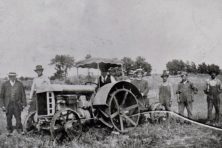Tips to Keep Farming Safe
- Share
- Tweet
- Pin
- Share
Farming is a dangerous job. In fact, the U.S. Bureau of Labor Statistics lists farmers, ranchers and other agricultural managers in the top 10 civilian occupations with high fatal work injury rates. One of the hazards faced by farm workers is contact with electrical equipment. Safe Electricity encourages farmers to keep safety top of mind this planting season. By doing some planning and following safety procedures, the risk of having an accident involving electricity can be greatly reduced.
“One critical part of safety around electricity is awareness,” explains Kyla Kruse, communications director of the Safe Electricity program. “It’s important to remember that farm machinery is vulnerable to hitting power lines because of its large size, height, and extensions. Being aware of the location of overhead power lines and planning a safe equipment route can help reduce accidents.”
In equipment with auto-guidance systems, less focus is needed on steering, which may lead some drivers to think that they do not need to be as aware of navigation issues. However, even while using a GPS with automatic steering, farm workers need to keep safety in mind and stay focused on their surroundings.
Putting safety first requires alertness, focus, and knowledge of potential hazards and appropriate safety steps. Varying pass-to-pass accuracy levels and potential issues, such as power poles not being correctly plotted in the system, reinforce the need for drivers to stay focused on the location of the tractor and its equipment while in the field and to be ready to take action themselves if necessary.
Regardless of what technology is used on the farm, keep the following electrical safety guidelines in mind:
- Use a spotter when operating large machinery near lines. A driver’s vantage point from the cab may not be sufficient.
- Keep equipment at least 10 feet from lines at all times, in all directions.
- Look up and use care when raising any equipment such as ladders, front-end loaders, or augers.
- Inspect the height of the farm equipment to determine clearance.
- Always remember to lower extensions to the lowest setting when moving loads.
- Never attempt to move a power line out of the way or raise it for clearance.
- If a power line is sagging or low, contact the utility.
- If equipment does make contact with a power line, do not leave the cab. Immediately call 911, warn others to stay away, and wait for the utility crew to cut the power.
The only reason to exit equipment that has come into contact with overhead lines is if the equipment is on fire, which is very rare. However, if this is the case, jump off the equipment with feet together and without touching the ground and vehicle at the same time. Still keeping feet together, hop to safety as you leave the area.
“When equipment has made contact with a power line, it is critical to know what to do,” Kruse adds. “Not knowing the proper procedures can result in serious injury or even death.”
For more information visit SafeElectricity.org.


